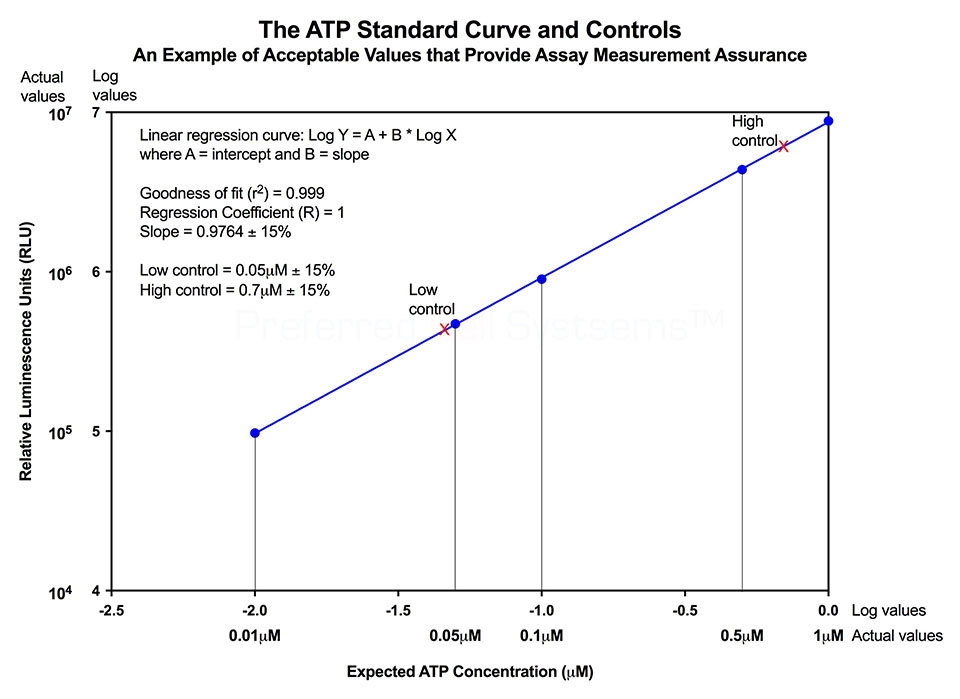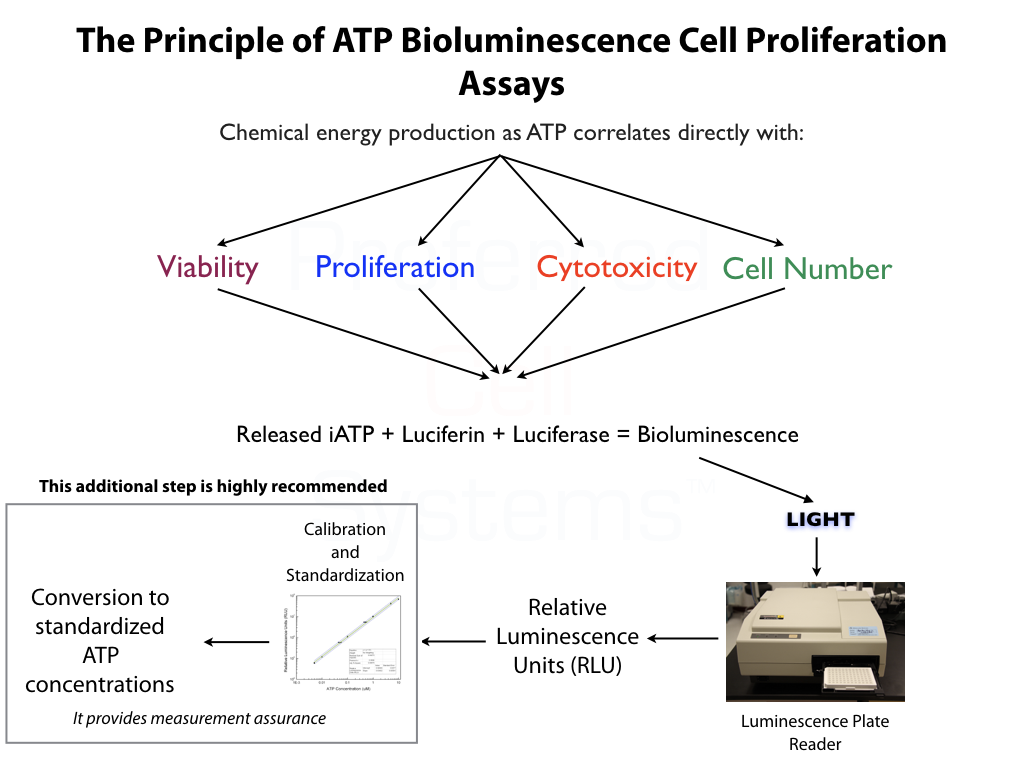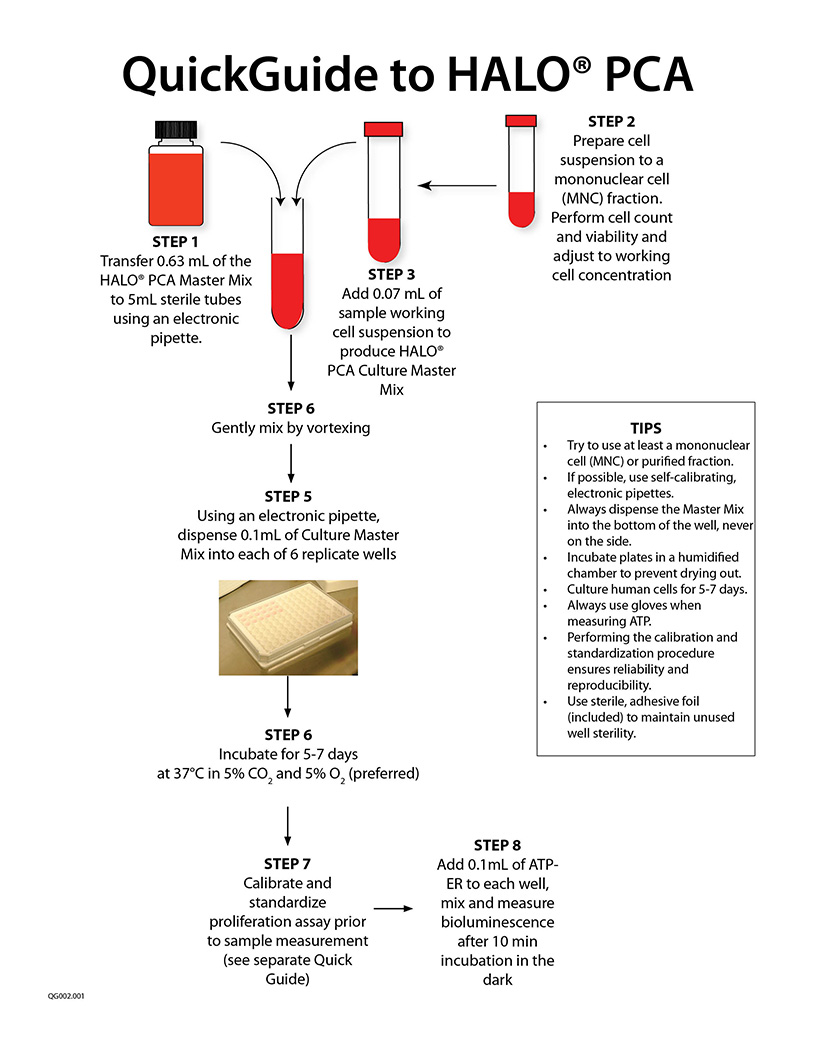HALO® PCA
Bioluminescence Progenitor Cell Assays for
Cellular Therapy
Download the Progenitor Cell Assay Flyer
HALO® PCA - Uses, Benefits and Characteristics
- Advanced replacement progenitor cells assays (PCAs) for the obsolete methylcellulose colony-forming unit (CFU) assay.
- Let the plate reader acquire and calculate results in 5 minutes or less.
- No 14 day cultures. Just a short 5 day incubation.
- No methylcellulose. Suspension Expansion Culture™ (SEC™) Technology makes methylcellulose obsolete. ATP bioluminescence technology provides the most sensitive, accurate and reliable readout for the rarest of cells.
- No extra costly proficiency testing. This is incorporated into HALO® PCA every time you use it. (See below. Calibration, Standardization and Proficiency Testing - The Role of Measurement Assurance).
- No additional controls and dubious CFU standards. Proper controls and standards included.
- Measurement assurance parameters provided to ensure your results are trustworthy.
- Use with cord blood, bone marrow, mobilized peripheral blood or purified cells (e.g. CD34+ or CD133+).
- Direct correlation with CFU. Predict CFU results making the use of the CFU assay obsolete. (See below. Correlation of HALO® PCA with the CFU assay).
- Similar growth factor cocktails to MethoCult™, but far superior.
- 96-well plates included in the kit. Smaller sample and reagent volume. Faster setup.
- Detect primitive stem and progenitor cells easily and efficiently.
- Directly compare your results over time and with other laboratories performing the same assay.
- Assay kits include everything you need to culture and measure cell growth. Just prepare and add cells.
- Time-efficient and cost-effective.
- Easy to learn in just 1 day.
There has been much talk and many publications about CFU standardization for cellular therapy. Companies have tried to address and negate the problems associated with the CFU assay by introducing dubious standards and so-called proficiency testing as well as expensive equipment to automate the tedious task of colony counting. Yet, the problems still remain; they are inherent in the assay itself. The mantra has been €œaccept and deny€; accept the problems and deny they are present so that the assay can continue to be used.
However, only Preferred Cell Systems™ has produced a solution to the flaws associated with the CFU assay, including standardization, verification, validation, measurement assurance and proficiency testing making the use of methylcellulose is obsolete.
With the introduction of Suspension Expansion Culture™ (SEC™) Technology and a non-subjective, instrument-based readout, all of the problems associated with using methylcellulose and counting colonies have been mitigated. That is something even the most ardent supporters and sellers of the CFU assay have never achieved. It all comes from thinking €œoutside the box€ and solving the problems that have remained unchanged for nearly 50 years.
Why is the methylcellulose CFU assay now obsolete? Because all the scientific results (see below) demonstrate that the HALO family of assays, of which HALO® PCA is one, outperform and outmaneuver any arguments propounded by CFU assay advocates.
Investigators can stay on the CFU assay bus and Preferred Cell Systems can accommodate them with CFU assays in 3 different formats. Alternatively, Preferred Cell Systems™ has everything you need to take cellular therapy testing to the next reliable level.
No additional proficiency testing is required if the calibration and standardization procedure is performed. The values you obtain from each calibration and standardization can be logged and used for certification that the assay has been performed correctly and that the results are trustworthy.

The table below shows the HALO® PCA assays that can replace any methlcellulose, colony-forming unit (CFU) reagent from any competitor. PLEASE NOTE that HALO® PCA incorporates Suspension Expansion Culture™ (SEC™) Technology to replace dispensing error-prone methylcellulose with reagents that use normal pipettes.
| HALO® PCA Number | HALO® PCA Cell Population |
Equivalent CFU Cell Population | Equivalent MethoCult™ Reagent | Growth Factor Cocktail |
|---|---|---|---|---|
| PCA1 | SC-GEM 2 | CFC-GEM 2 | H4434 "Classic" | EPO, GM-CSF, IL-3, SCF |
| PCA2 | SC-GEM 3 | CFC-GEM 3 | H4034 "Optimum" | EPO, GM-CSF, G-CSF, IL-3, SCF |
| PCA3 | P-GM 1 | GM-CFC 1 | H4534 "Classic" | GM-CSF, IL-3, SCF |
| PCA4 | P-GM 2 | GM-CFC 2 | H4035 "Optimum" | GM-CSF, G-CSF, IL-3, SCF |
| PCA5 | SC-GEMM 3 | CFC-GEMM 3 | H4435 "Enriched" | EPO, GM-CSF, G-CSF, IL-3, IL-6, SCF TPO(#) |
| PCA6 | SC-GEMM | CFC-GEMM 1 | MethoCult "Express" | EPO, GM-CSF, IL-3, IL-6, SCF TPO Flt3-L |
(#) denotes that the Preferred Cell Systems™ formulation of this product includes TPO that stimulates the production of megakaryopoiesis. MethoCult and other competitor formulations of this specific product do not include TPO, do not stimulate the production of megakaryocytes and threfore do not detect the CFC-GEMM stem cell population.
HALO® PCA can be used for the following tissues:
- Mobilized peripheral blood
- Umbilical cord blood
- Bone marrow
- Purified cell populations for any of the above tissues
The recommended cell purity is a mononuclear cell (MNC) fraction. A total nucleated cell (TNC) fraction is not recommended as this contains high concentrations of cell impurities, such as red blood cells, neutrophils, platelets and other cells that severely underestimate and even inhibit the detection of progenitor cells.
- Standardization of the CFU-GM assay using hematopoietic growth factors. J. Hematotherapy:6:191-192 (1997)
- Development of a novel assay to evaluate the functional potential of umbilical cord blood progenitors. Transfusion. 48:620-628 (2008).
- Potency, Proliferation and Engraftment Potential of Stem Cell Therapeutics: The Relationship between Potency and Clinical Outcome for Hematopoietic Stem Cell Products. J Cell Sci Therapy. (2013).
- Detecting primitive hematopoietic stem cells in total nucleated and mononuclear cell fractions from umbilical cord blood segments and units. J Translational Medicine 13:94 (2015)
- Improving quality and potency testing for umbilical cord blood: A New Perspective. Stem Cells Translational Medicine. 4:967-973 (2015)
- Hematopoietic stem cell potency for cellular therapeutic transplantation. In: Hematopoietic Stem Cells, Ed. Rosana P. Camacho. Published by: InTech Open Access Publisher. ISBN 978-953-307-746-8. (2011).
- Measuring the Potency of a Stem Cell Therapeutic. In: Stem Cell Protocols. Methods in Molecular Biology, 1235, Ed. Rich IN. Published by Human Press (2015).
- Bioluminescence Potency Measurement of Cellular Therapy Products. In: Cellular Therapy: Principles, Methods, and Regulations, 2nd Edition, Eds. Areman EM and Loper K. Published by AABB.
- Present Cord Blood Testing Fails to Determine if the Stem Cells Used for Transplantation are of High Quality and PotencyThe Parents Guide to Cord Blood Foundation
- The Difference Between Stem Cell Viability and Potency: A Short Guide for Parent and Patients. The Parents Guide to Cord Blood Foundation
Correlation of HALO® PCA with MethoCult™ CFU Formulations:
Why Methylcellulose CFU Assays are now Obsolete.
Top Diagram; Upper Graph
The upper graph demonstrates a direct correlation of HALO® Progenitor Cell Assays (PCA) measured on day 5 with the equivalent MethoCult™ formulations for which colony counts were assessed on days 7 and 10. The correlation coefficient (r2) is lower on day 7 than on day 10. This is to be expected, since colonies cannot be differentiated on day 7. Nevertheless, the correlation between the measured ATP concentrations on day 5 signifcantly correlate with the colony counts on days 7 and 10 for each of the different growth factor formulations used (see lower graph). Note also that there is a correlation between the primitive hematopoietic stem cell population SC-GEMM 1, measured on day 5 and MethoCult Express, determined on day 7. Indeed, there is no advanatge to using the more expensive "Express" formulation. These correlations indicate not only that any HALO® PCA assay can predict the results of the equivalent MethoCult formulation, but all HALO® PCA assays can replace all of the MethoCult™ CFC assay reagents with far greater accuracy, sensitivity, precision and reproducibility.
There are 2 primary reasons for this. (1) All HALO® assays were originally derived from the traditional CFU assay. (2) All HALO® assay measure cell proliferation, which occurs prior to the differentiation of cells allowed in the CFU assay.
Top Diagram; Lower Graph
The lower graph is an extension of the upper graph in that it includes HALO® PCA5,which is equivalent to using MethoCult H4435 "Enriched". In this graph, the ATP measurements have been extended to 7 days instead of 5 days. The result is a higher correlation coefficient between the two assays. Again any of the CFU assays can be replaced by a HALO® PCA assay, making the use of methylcellulose CFU assays obsolete.
Bottom Diagram
The bottom diagram shows the correlation between HALO® PCA formulations and equivalent MethoCult™ CFU formulations for human bone marrow. The correlation coefficients are even greater than for cord blood, indicating the higher variability of the CFU assay when cord blood is used.
These results clearly demonstrate that the methylcellulose CFU assays are now obsolete, since HALO PCA predicts and produces far superior results and is significantly more reliable and reproducible.
It should also be noted that similar correlations occur when using HemoFLUOR™ PCA or HemoLIGHT™ PCA instead of HALO® PCA.
When You Use HALO®, No Colony Counting is Necessary
Another reason why the CFU assay is obsolete is because HALO® make it unnecessary to count colonies.
Since HALO® does not use methylcellulose, no colonies are produced. Instead, HALO® incorporates Suspension Expansion Culture™ (SEC™) Technology; cells are cultured in suspension. This means it is easier, faster and more accurate to setup HALO® cultures because normal pipettes are used. The question always asked is: If no colonies are produced, how do I know whether the cells have differentiated and how do I detect cell differentiation? The answer lies in flow cytometry. The type of cells produced is dependent on the growth factor cocktail used, just as it is in a normal CFU assay. The diagram above show this. If a SC-GEMM culture is setup in HALO®, you would expect to see the presence of stem cells, erythroid cells, granulocytes and macrophages and megakaryocytes, because that is the definition of the SC-GEMM stem cell population. If the cells are removed from a SC-GEMM culture and analyzed by flow cytometry, these are precisely the cell types that are present in the culture as seen by the blue columns. Similarly, if SC-BFU cultures are setup, you would expect to see a prevalence of CD235a+ (glycophorin-A) cells and that is exactly what you find, together with some granulocytes and macrophages as well as megakaryocytes. In other words, the cells you detect in HALO® cultures by flow cytometry are the cells you would expect for the growth factor cocktail used. Therefore, waiting for differentiation to occur and enumerating different types of colonies is unnecessary when using HALO®.
For Research Use Only. Not for clinical diagnostic use.
Luminescence or multimode plate reader with "glow" luminescence measuring capability.
- HALO® PCA Master Mix
- ATP standard
- ATP high and low controls
- ATP Enumeration Reagent
- Sterile, 96-well plates
- Non-sterile, 96-well plates
- Sterile, adhesive foil covers
To learn how to setup and use Progenitor Cell Assays (PCAs), click on the video links below:
How to Perform a Progenitor Cell Assay (PCA) - An Alternative to All Methylcellulose CFU Assays
How to Calibrate and Standardize an ATP Bioluminescence Assay - Part 1 (for HALO® PCA only)
How to Calibrate and Standardize an ATP Bioluminescence Assay - Part 2 (for HALO® PCA only)
Proficiency Testing of Hematopoietic Cellular Therapy Products (for HALO® PCA only)
Download the ATP Optimization Kit Protocol for First-Time Users
Download Luminometer Setup and RLU to ATP Conversion
Download Certificate of Analysis (CoAs) for ATP Enumeration Reagent (ATP-ER)
Download Certificate of Analysis for ATP Stanadrds
Download Certificate of Analysis for ATP Controls
Download Certificate of Analysis of ATP Reconstitution Reagent
Download Certificate of Analysis for Sterile 96-Well Plates
Download Certificate of Analysis for Non-Sterile, 96-Well Plates
Download Certificate of Analysis for Sealing Films
Download Certificate of Analysis for IMDM


